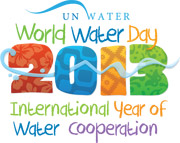Do you think cooperation is difficult?
Although it is a potential source of conflict, there are many good examples of peaceful cooperation:
The Valencia Water court
Every Thursday at noon in the cathedral square in Valencia (Spain), at the first strike of the cathedral bell, an “alguacil” or constable comes out of an adjoining building. He is followed by eight men dressed in the long black shirts traditionally worn by farmers in the region. They are members of the ancient institution of the Tribuna del Agua. In public hearings, the court settles disputes on the distribution of water among the eight channels that irrigate the 17,000 hectares of farmers' land, where citrus fruits, rice, grapes and peaches are grown for the Spanish and international markets. It was inscribed on UNESCO’s Representative List of the Intangible Cultural Heritage of Humanity.

One of the eight irrigation canals of the Turia under the jurisdiction of the Tribunal de las Aguas of Valencia. Every Thursday morning the judges selected from among the farmers and elected by them, meet to settle the disputes of the farmers regarding the distribution of the Turia's waters.
©UNESCO 2006/José Jordan
Lake Titicaca
Twenty years ago, Bolivia and Peru created the Bi-national Autonomous Authority of Lake Titicaca recognizing the importance of the joint management of the lake. This institution aims to defuse potential water-related conflicts and foster cooperation.
Treaty for the Dniester Basin
In November 2012, the Republic of Moldova and Ukraine signed the bilateral Treaty on Cooperation on the Conservation and Sustainable Development of the Dniester River Basin. The new Treaty identifies principles and provides a framework for cooperation on water pollution prevention and control, water flow regulation, and conservation of biodiversity.
Arab Ministerial Water Council
Arab States are using various cooperation mechanisms to manage their shared water resources in a water-stressed region, such as the Arab Ministerial Water Council. It held its first ministerial session in June 2009, in Algiers. The Council defined a strategy for 2010-2030.
Mekong River Basin
The Mekong River Basin illustrates the complex relations between states and rivalry among water institutions. Transboundary water conflicts have generally been contained in this basin, but the increase of water scarcity due to environmental and developmental factors could undermine this delicate balance in the future.
A Joint Commission between Canada and the United States
Canada and the United States of America share many river basins and some of the largest lakes in the world. Established under the 1909 Boundary Waters Treaty between the US and Canada, the International Joint Commission helps the governments of both countries find solutions to manage their shared waters.

An aerial view of one of the tributaries of the Niger River.
©UN Photo/Shaw McCutcheon
An expert network in the Nile Basin
The Nile Basin Initiative’s Socio-Economic and benefits Sharing Project (2010) aims to build a network of professionals, experts, representatives from the public and private sectors, academics, and sociologists from across the basin to explore benefit-sharing schemes.
The Indus Water Treaty
The Indus Water Treaty, signed between Pakistan and India in 1960, has survived three major conflicts and remains valid today.
The Guarani Aquifer
The Guarani aquifer is shared by Argentina, Brazil, Paraguay and Uruguay. In August 2010, the presidents of the four countries signed an agreement for cooperation on extending knowledge of the aquifer and on identifying critical areas. The four countries have committed themselves to promoting the conservation and environmental protection of the Guarani Aquifer System to ensure equitable use of its water resources.

